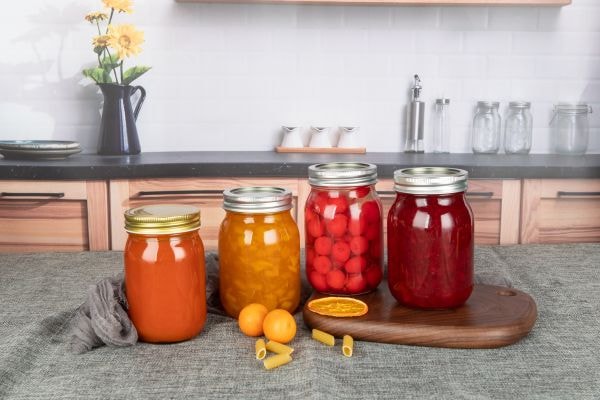
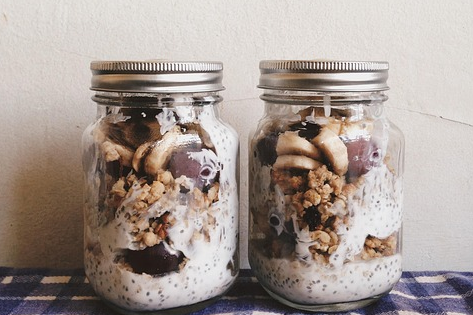
Introduction to Mason Jars
While most people know them as canning jars, mason jars have several other uses. A clear jar with a screwed on lid, retailers seem to have the most uses from product to craft supply displays.
But what are the ideal jar sizes for your brand? In this post, we explain what mason jars are, their types, sizes, and how to choose the right one for you.
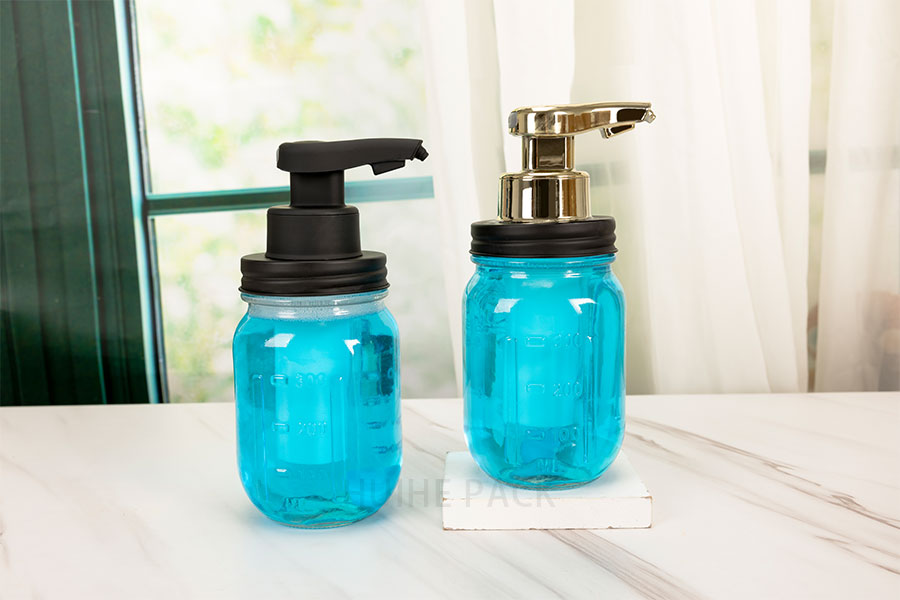
What Are Mason Jars?
A mason jar is a clear glass jar used initially for canning fruits and vegetables. The jar was invented by John Landon Mason, who patented it in 1858. After the patent eventually expired, many other companies manufactured their versions.
In the 20th century, farmers would use the mason jars to can jams, pickles, and sauces, and display them at fairs. Over the years, the jars’ uses have multiplied to include vases for flowers, soap dispensers, candle holders, and storage containers.
Common Materials and Features


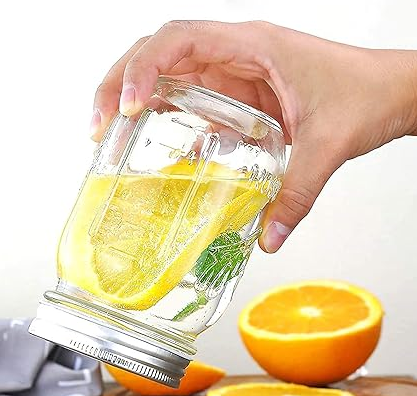
Glass is the most popular material for making mason jars. You can use metal jars, but unfortunately, they cannot be reused. Metal jars are also quite expensive and need special sealing equipment. On the other hand, glass is durable and safe for food products.
For sealing the jars, there is a flat metal lid. The lids create a tight seal that blocks the air from entering and helps keep the content fresh. Avoid using lids that are old, dented, or have other defects. Plastic lids are ideal for storage purposes, like in the freezer, but not for home canning.
The metal lid has a colored gasket compound at the bottom end. After the mason jars are filled, the gasket softens and spreads across the sealing surface of the jar. It creates a tight seal while still allowing air to escape the jar.
A metal screw band holds the lid in place while processing. Remove the metal band after the jars have cooled and before storage. Wash and dry the bands before storing them, and you can reuse them multiple times. Keeping the bands on the jars makes it hard to take them off and can cause them to rust over time.
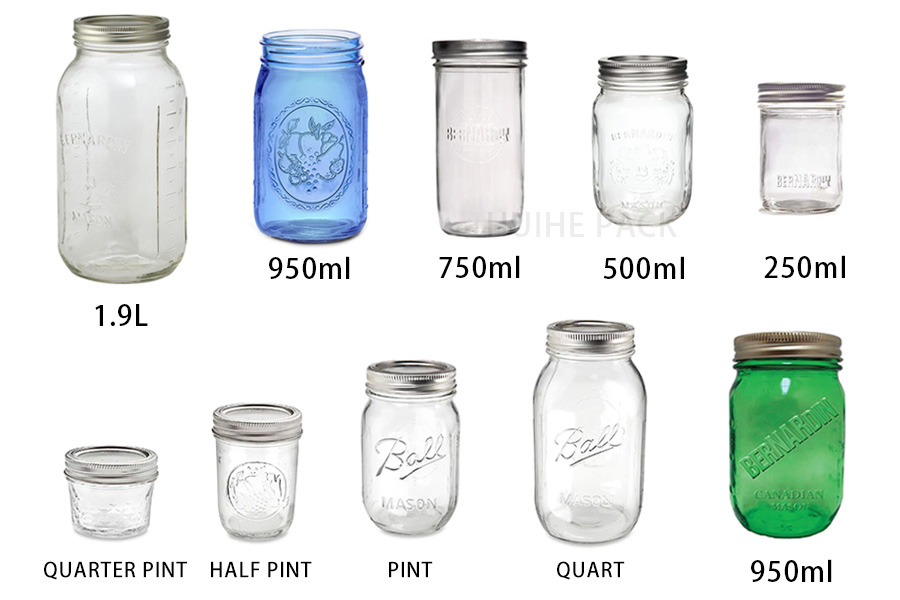
Leading Mason Jar Brands
Ball Corporation is the most recognized brand. Ball jar sizes include pint, quart, and half-pint. The brand’s jars are primarily available in the Eastern United States. The jars are crafted from premium glass and feature secure, two-piece sealing lids. The sides of the jars have raised measurement markings.
Kerr brand jars have a smooth back, ideal for labelling. Kerr offers half-pint, quart, and half-pint sizes, and most have wide mouths. The jars are heat and freezer-safe, and replacement lids are available.
Bernardin brand is the largest supplier of mason jars in Canada. It has a collection of metric measurements in ml and litres. Bernardin jars come in three different colors (clear, green, and purple) and two different styles (round and slightly squared off sides). Their wide-mouth version is available in different sizes compared to the regular mouth option.
Newell Company owns all the above brands. The choice for a specific brand will depend on preferences and regional availability.
Why Mason Jar Sizes Matter

Choosing the right jar size can highly impact the intended use. Food products require different sizes depending on the type and quantity. Whole vegetables and fruits fit better in wide-mouth jars, while regular mouth jars are suitable for smaller items and liquids.
Storing small amounts in oversized jars may cause spoilage because of the extra air inside. Hence, use small jars for storing smaller quantities of spices, individual portions, herbs, or leftovers. Larger sizes are for bulk item storage.
Jar sizes will also matter when organizing your space. Use various sizes to fit more efficiently in the fridge or pantry. Factor in expansion and contraction space and choose the ideal jar when freezing.
Types of Mason Jars
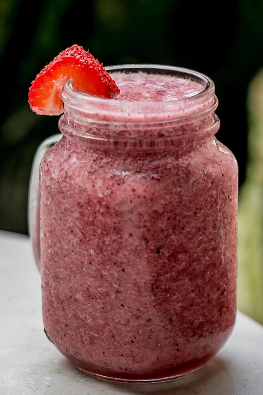

Regular Mouth Mason Jars
The opening of regular mouth Mason jars is 2 3⁄8″ (60 mm). It has a shouldered, narrower opening, making it easier to pour without spilling. It is ideal for liquids, jellies, sauces, and jams. The majority will fit pour spouts and lids. Because it is compact, it can fit on tight shelves.
However, its narrow opening makes it challenging to clean the inside, especially if you use it for storing nut butters. Regular mouth mason jars tip or topple when you try to stack them.
Wide Mouth Mason Jars

The opening for wide-mouth mason jars is around 3 inches (76 mm). The wide-mouth design allows for simpler filling and easier cleaning. Scooping out the jar’s content is also easier. It is the ideal canning jar for grains, whole fruits, and vegetables. Wide-mouth jars are easier to stack in storage.
One of the limitations is that wide-mouth mason jars occupy extra space.
Jar Sizes and Capacities

Common Mason Jar Sizes
Smaller jar sizes range from 4 oz, 8 oz (half pint), 12 oz, and 16 oz (pint). But how many oz are in a mason jar? Measurements for jars are usually in mm(milliliters) or fluid ounces.
- 1 milliliter =0.033814 fluid ounces, for example 118mm= 4 fluid ounces.
Larger jars range from 32 oz (quart), 64 oz (half gallon), and 128 oz (gallon).
Most brands will indicate the measurements on the side of the jar. If none, you can use a ruler, tape measure, or metric measure. Consider the mason jar specification before buying to see if it fits your needs.
Capacity and Use Cases
Different mason jar sizes have various uses.
Mason Jar Sizes | Features |
4 oz | Suitable for storing small quantities of spices, jams, and jellies. |
8–12 oz | Ideal for preserving snacks, homemade preserves, gifts, and single-serving desserts—or for neatly storing everyday bits like cotton swabs. |
Pint (16 oz) | It’s the perfect size for preserving fruits and vegetables, packing salads and sauces, ready-to-go meals, and storing or drinking liquids—plus it can be fitted with a pump or lid to hold hand soap and other bathroom essentials. |
Quart (32 oz) | Great for storing large quantities of dry foods like cereals, rice, pasta, or for picking up pickles and soups. Its size is also perfect for preparing and holding iced tea, lemonade, leftovers, or meal preps. |
Half Gallon (64 oz) | Perfect for storing bulk dry ingredients like grains, flour, and sugar. |
Gallon (128 oz) | As the largest size offered, it’s perfect for keeping homemade beer, kombucha, wine, or sauerkraut. Alternative uses include being a decorative item for parties or special events. |
Canning with Mason Jars
Why Mason Jars Are Ideal for Canning
Crafted from strong, premium-quality glass, mason jars are ideal for canning. The glass can withstand the intense heat and pressure required during the canning process. Recommended methods of canning include atmospheric steam or boiling water baths, which use high heat.
The combination of the flat-metal lid and the gasket sealing compound on the underside of the lid provides an airtight seal. Once the jar cools, the gasket hardens into an airtight seal.
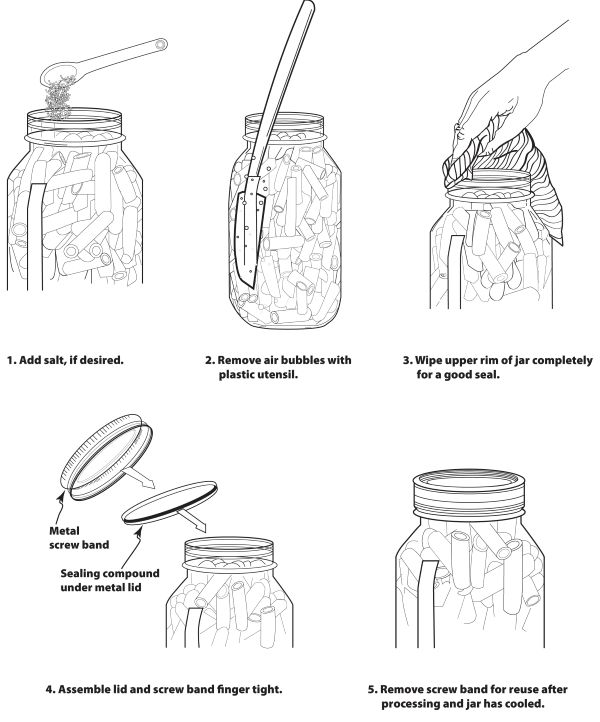
Essential Canning Supplies
Before starting the canning process, it is essential to ensure you have all the necessary supplies and equipment.
- Mason jars, lids (preferably new), jar lifter (safely removing the hot jars and bands.
- A water canning bath or a large stock pot (and rack) for processing the filled jars and for sealing.
- A ladle for scooping hot foods and liquids, and a canning funnel to prevent spilling, keeping the rims free for a good seal.
- Labels to list the contents inside the jar and the date.
- Paper towels/clean cloths for wiping the jars.
Selecting the Right Jar Size for Canning
High-acid foods are safely processed in a steam canner or boiling water. Fruits, pickles, jellies, and jams are some of the high-acid foods that can fit in smaller (4 oz, 8 oz) and medium-sized (pints, quarts) mason jars.
Low-acid foods are best preserved in bigger jars, like the half-gallon size. Meats and vegetables are good examples of low-acid foods. Pressure canning is the ideal method for preserving low-acid foods to prevent harmful bacteria growth.
Safe Canning Practices
Following safe home canning practices is essential to prevent food-borne diseases. Only use recipes that are approved by the U.S. Department of Agriculture (USDA) and other trusted sources.
Sterilize the jars and other equipment with hot soapy water, rinse and dry them thoroughly to prevent contamination. Follow the recommended temperatures and processing times to ensure a proper seal and prevent harmful bacteria.
After processing, check the seals after the jars cool down.
Choosing the Right Jar
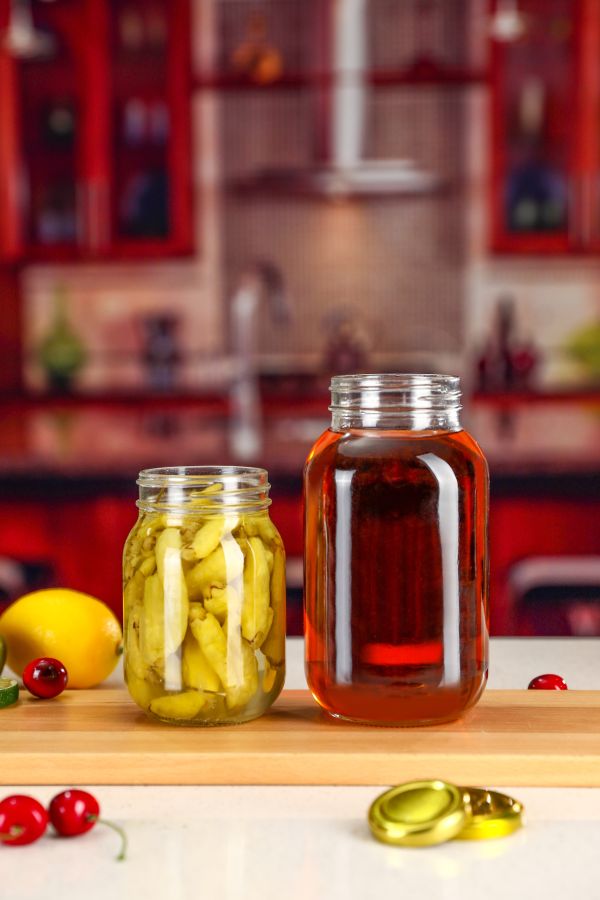
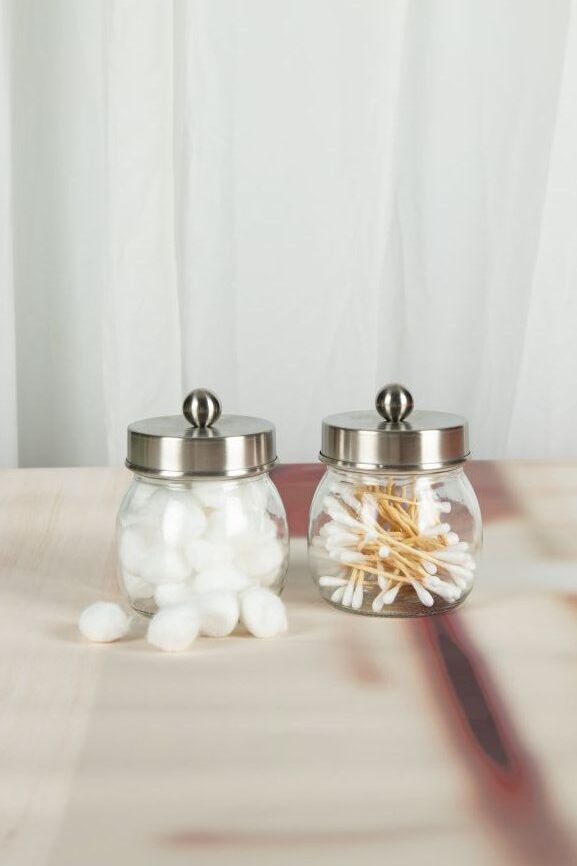
When selecting the ideal mason jars, there are a few things you need to keep in mind. What food processing and storage method are you going to use? Canning, freezing, or keeping in the pantry? Choose wide-mouth or regular mouth jars for canning, and the size will depend on the quantity of food you’re preserving.
Straight-sided jars are ideal for food freezing as they can expand without breaking. However, avoid jars with shoulders as they break when the foods expand.
Use wide-mouth jars for dry goods that you have to scoop, such as flour or larger items, such as beans, when storing foods in the pantry.
Mason Jars Lid Types
The most common type is the flat metal lid with a screw band. It is the ideal type for canning. The flat metal lid seals the jar and is single-use. The metal screw band is reusable as it only holds the metal lid down during processing.
Plastic lids are ideal for fermentation as metal lids corrode. These lids are reusable and are suitable for everyday use.
Brand and Quality
Established brands such as Ball or Kerr have a reputation for using thick, durable glass for their mason jars. Their jars are free from harmful chemicals and follow strict manufacturing standards.
Reputable brands have consistent performance, and you’ll have no worries about your canning and preservation outcomes.
Conclusion: Choosing the Perfect Jar
Picking the right mason jar depends on the intended use. Small mason jars are ideal for jams, jellies, pickles, and small quantity items. Large mason jars are suitable for soups, drinks, and chunky food products. They also double as tidy organizers for cotton pads, spices, or craft bits.
HUIHE PACK manufactures high-quality jars and packaging solutions. Contact us for premium mason jars.

FAQ About Mason Jar Sizes
Q1: How many oz in a standard mason jar?
A standard mason jar holds 16 fluid ounces, and is often referred to as a pint. The quart mason jar holds 32 fluid ounces.
Q2: Are Ball jars and Mason jars the same?
A Mason jar is the general term for this style of glass jar, while Ball is one of the brands that produce them.
Q3: What’s the biggest mason jar available?
The biggest mason jar that you can buy commercially is the one-gallon size. It is the ideal size for storing large quantities of food such as candies, grains, or craft displays.
Q4: How big is a 32-oz mason jar?
The 32-oz regular mouth quart can hold up to 4 cups of fluid. It is around 6.7 inches tall and 3.6 inches in diameter.
Q5: What size mason jar is 12 oz?
The 12-oz mason jar holds 1.5 cups with a height of 5.33 inches.
Q6: Can Mason jars be used for items other than food?
Yes. Food-grade Mason jars are safe for storing food, while regular ones work well for household supplies (like cotton swabs, nails, or small craft tools). They’re also great materials for DIY projects—such as candle holders, flower vases, or storage organizers.




